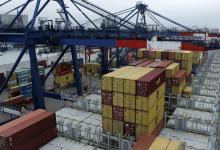
Typical street scene in Santa Ana, El Salvador. (Photo: iStock)
IMF Survey : Asia and Latin America Look to Strengthen Trade, Financial Ties
March 10, 2016
- Trade and financial ties between Asia, Latin America have strengthened, but regions face challenges going forward
- China slowdown affecting Latin America’s commodity exporters, financial flows may be affected
- The Trans-Pacific Partnership can be a good deal for global trade
There is great potential to deepen trade and financial linkages between Asia and Latin America, and implementing the right policies will be key to a successful partnership, conference participants said.

Shipping containers in the Port of Callao, Peru. Asia has become a major export market for Latin America’s commodities (photo: Mariana Bazo/Newscom)
Asia-Latin America Conference
The March 3 conference, entitled “Economic Linkages between Asia and Latin America: Opportunities, Challenges, and Policies,” noted that trade and financial ties between Latin America and Asia have clearly strengthened over the past decade. China in particular has become a major export market for Latin America’s commodities. Investment flows between both regions have also been growing, especially from Asia to Latin America.
But uncertainty about the future is higher. Rebalancing of economic activity in China (from investment and manufacturing toward consumption and services), weaker commodity prices, and tighter global financial conditions are bearing down on Asia and Latin America. These developments are also weighing heavily on global trade.
“For the first time in 20 years, trade growth is slower than GDP growth,” said IMF Deputy Managing Director Min Zhu in his opening remarks. The key issue for both regions is finding ways to promote growth and trade, he said.
Zhu also mentioned the large number of trade agreements between both regions. In the past 10 years, both continents have signed many trade agreements—from 2 in 2004 to 22 in 2013 and more are expected. “The key to success with trade agreements is implementation, implementation, implementation,” Zhu said.
The conference, held at IMF headquarters in Washington, D.C., brought together academics, regional experts, as well as senior policymakers, including U.S. Trade Representative Michael Froman. Conference participants also discussed how the new Trans-Pacific Partnership (TPP)—a trade agreement among twelve Pacific Rim countries signed last month—would affect both regions as well as the global trading system.
A shifting relationship
Panelists discussed the recent and potential spillovers between China and Latin America, and the risks associated with them. According to Andres Gluski, President and CEO of AES Corporation, the most important near-term risk to the trade relationship between Asia and Latin America was the price of commodities, which are driven by the growth in China. Against this backdrop, Margaret Myers, a Director at the Inter-American Dialogue, considered the “diversification of engagement” as a critical issue for both regions in the longer run. The current model of engagement—where about 80 percent of lending by Chinese policy banks to Latin America focused on extractives and infrastructure development—perpetuated commodity dependencies, Myers said. Bank lending has also slowed given weaker commodity prices and lower growth in both China and Latin America.
Xie Wenze, a Professor at the Institute of Latin American Studies at the Chinese Academy of Social Sciences, mentioned three areas where the relationship between Asia and Latin America could be strengthened further over the next 5-10 years—trade, production chains, and infrastructure. In the past, the economic cooperation between both regions was mostly driven by trade, but from now on financial cooperation will be the most important engine, added Wenze.
But Moises Naim, a Distinguished Fellow at the Carnegie Endowment for International Peace, pointed out that both regions would first need to “realign their relationship.” In the case of China, the country would need to move away from being a “generous lender—where no questions were asked and not much due diligence performed—to a collector of bad debts.” Several panelists agreed and called on China to increase transparency and rely on more market-based mechanisms in its lending strategy.
A new partnership
Conference participants debated how the TPP would affect the evolving relationship between Asia and Latin America. The TPP is the largest regional trade agreement involving advanced and developing countries, and also the most comprehensive in scope and depth of liberalization, said Jeffrey Schott, a Senior Fellow at the Peterson Institute for International Economics. It’s also a “living agreement”—meaning that new countries could join after the TPP enters into force. Caroline Atkinson, former U.S. Deputy National Security Advisor, said she was optimistic that the TPP could be ratified this year by the U.S. Congress.
“The TPP could lead to nearly $500 billion in permanent real income gains and more than $1 trillion in exports of goods and services above baseline projections,” said Schott. While the U.S. and Japan account for most of the gains (about 55 percent), Vietnam and Malaysia stand to gain the most as a share of GDP. For Japan, the TPP is “tremendously important” and allows the country to “jump ahead to a global free trade agreement network,” said Takatoshi Ito from Columbia University. Countries like Thailand, Indonesia, Korea, and the Philippines, currently not members of TPP, would benefit strongly from joining. But China’s accession would be the real game changer in terms of boosting the gains for all participants, said Herminio Blanco, former Mexico Trade and Industry Minister.
Panelists considered the TPP a ground-breaking deal as it covered six major chapters (services, investment, labor, environment, intellectual property rights, and digital trade), set high standards on labor and environmental issues, and included new areas such as e-commerce. TPP puts a premium on eliminating unnecessary barriers to trade that stand in the way of firms being able to take advantage of the global economy and export their products,” said U.S. Trade Representative Michael Froman.


